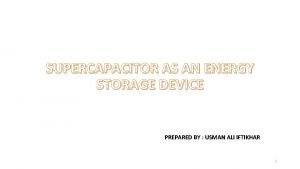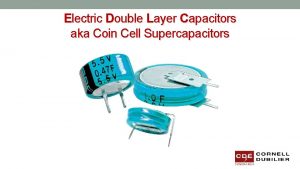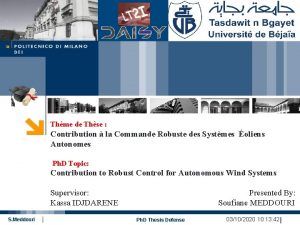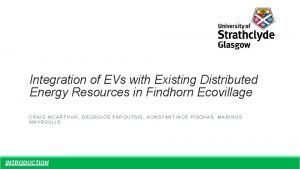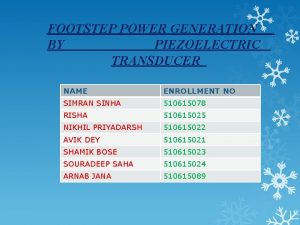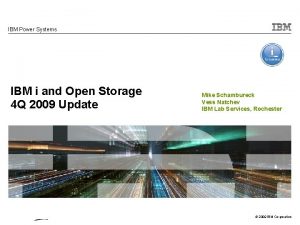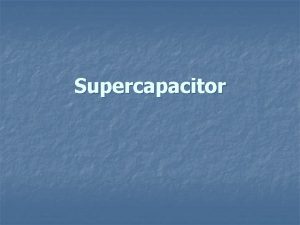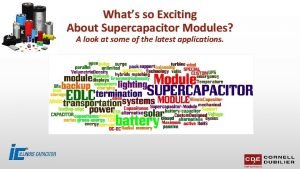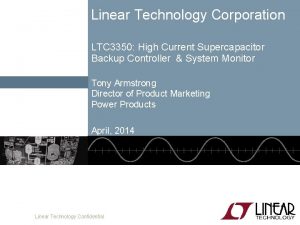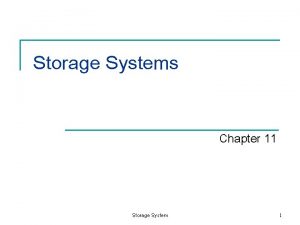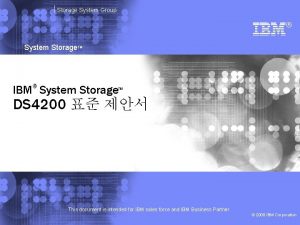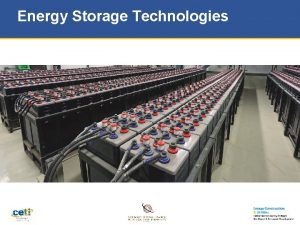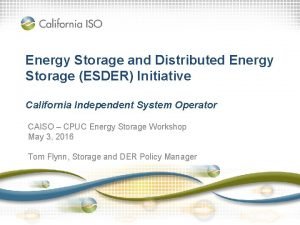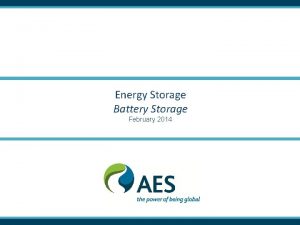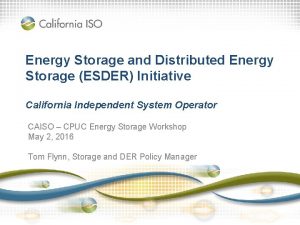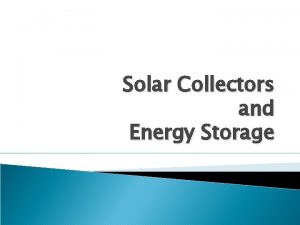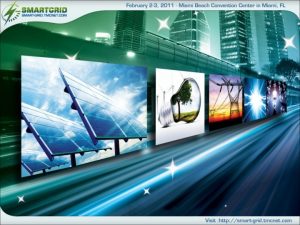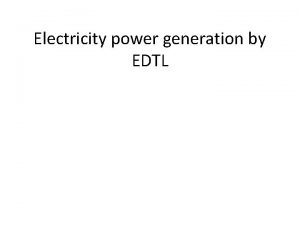Supercapacitor Energy Storage System for PV Power Generation





















- Slides: 21

Supercapacitor Energy Storage System for PV Power Generation Institute of Electrical Engineering, Chinese Academy of Sciences Supported by Ministry of Science and Technology, China May, 2004

Applicable Energy Storage Technology for PV Power Generation • The lead-acid battery is popular in PV generation system because of its low cost, but its life cycle is low. Also it will cause environment problem. • Other battery like nickel-metal-hydride battery, Li-ion battery have advantage of high energy density, but they are expansive. • Supercapacitor is becoming an attractive new technology for energy storage.

Feature of the Supercapacitor Advantages: High life cycle (>500000 cycled times) l Quickly charge/discharge (>1000 A) l Operating temperature range (-50℃-70 ℃ ) l Environment friendly l Limitations: Low energy density l Linear discharge voltage prevents use of the full energy spectrum. l Cells have low voltages l High self-discharge l

The Key Issues for Supercapacitor Energy Storage System • Usually the supercapacitor cell with aqueous electrolyte allows 1 V of charge , Whereas organic electrolyte allows 2. 5 volts of charge. To operate at higher voltages, supercapacitors are connected in series. On a string of more than three capacitors, voltage balancing is required to prevent any cell from reaching overvoltage. • The gravimetric energy density of the supercapacitor is 1 to 10 Wh/kg. Compare to battery, it is lower. Whereas the voltage of the supercapacitor is linear and drops evenly from full voltage to zero volts. Because of this, the supercapacitor is unable to deliver the full charge.

In China the supercapacitor as product its technology level: • energy density: about 4 Wh/kg • life cycle: 100000 -500000 cycled times • operating temperature range (-40℃-70 ℃ ) In order to set up the test system of supercapacitor energy storage, we have investigated two kind supercapacitors from two Chinese companys: • the supercapacitor cell with organic electrolyte: 2700 F, 2. 7 V, 500000 cycled times • the supercapacitor cell with aqueous electrolyte: 20000 F, 0. 7 V, 100000 cycled times

1 k. W PV Power Generation with Supercapacitor Energy Storage(300 Wh/2 k. Wh) PV Array Super. Buck Charger capacitor Bank Energy Management And Control Boost DC/DC Converter Load

Test System of Supercapacitor Energy Storage (500 W/60 Wh) AC Power Supply Super- Charger Capacitor Bank DC/DC DC/AC Converter Inverter Computer

The Picture of the Test System of Supercapacitor Energy Storage (500 W/ 60 Wh)

The supercapacitor bank is consist of 20 cells with organic electrolyte: • 2700 F, • 2. 7 V, • 500000 cycled times • full discharge

The Study of Supercapacitor Bank • The Principle of Voltage Balancing for serial connected supercapacitor cells

• The Principle of exchange between serial and parallel connected for supercapacitor cells

• The Structure of 60 Wh Supercapacitor Bank

The result of Voltage Balancing of the Supercapacitor Bank (Current of Charge: 2 A Charge duration: 76 mintues) Number of Cells C 1 C 2 C 3 C 4 C 5 Voltage of End Charge (V) 2. 79 2. 77 2. 78 2. 77 2. 82 Number of Cells C 6 C 7 C 8 C 9 C 10 Voltage of End Charge(V) 2. 78 2. 81 2. 79 2. 77 Number of Cells C 11 C 12 C 13 C 14 C 15 Voltage of End Charge(V) 2. 79 2. 77 2. 82 2. 78 Number of Cells C 16 C 17 C 18 C 19 C 20 Voltage of End Charge(V) 2. 78 2. 80 2. 78 2. 77

The simulation of Charge and Discharge for 60 Wh supercapacitor Bank ( Current of Charge: 1 A ,The Load of Discharge is Resistance )

Voltage Wave of Supercapacitor Bank during Charging at Exchange Point from Serial to Parallel Connected ( Current of Charge: 2 A,Tracking Duration : 50 s)

Voltage Wave of Supercapacitor Bank during Charging at Exchange Point from Serial to Parallel Connected ( Current of Charge: 2 A,Tracking Duration : 500 s)

The Current and Voltage Wave of Supercapacitor Bank during Charging at Exchange Point from Serial to Parallel Connected (Constant Load-Computer: 200 W, Tracking Duration : 400 ms)

Study of the Efficiency of Supercapacitor Bank Charging • Supercapacitor by constant voltage charging, the efficiency can be up to 50% • Supercapacitor by constant current charging, the highest efficiency can be gotten。Because of the serial and parallel resistance in Supercapacitor, they will consume electricity when charging. The amount of charging current will affect the charging efficiency. • Many times experiments show that the smaller charging current can lead to higher efficiency.

Charging Efficiency under Different Charging Current (Charging Current from 0. 5 A to 14 A)

Study of the Efficiency of Supercapacitor Energy Storage System • Voltage balancing can overcome the problem of the capacitance difference. Each cell can be fully charged. • Through changing from parallel to serial connected, more energy can be output. For example, the supercapacitor bank change from parallel to serial connected for one time while output through DC/DC converter with 1: 0. 5 input range, the supercapacitor bank can output 93. 75% stored energy. • Voltage balancing , changing from parallel to serial connected , high efficiency electronic circuit including charging and discharging converter, The total high efficiency of energy storage can be reached.

Summary • This project has already built a test system of supercapacitor energy storage (500 W/60 Wh), the total efficiency of energy storage is over 60%. • Now the research work is focusing on the development of supercapacitor banks (1 k. W/300 Wh and 1 k. W/2 k. Wh), energy manager for PV power generation system with supercapacitor energy storage. • In order to increase the energy density of supercapacitor, we are collaborating with the manufacture to increase internal resistance properly for large energy storage usage.
 Supercapacitor energy storage system
Supercapacitor energy storage system Define tecate
Define tecate Coin cell supercapacitor
Coin cell supercapacitor First gen antipsychotics
First gen antipsychotics You're good and your mercy is forever
You're good and your mercy is forever Power triangle diagram
Power triangle diagram 2.thme
2.thme Exporter+energy storage system
Exporter+energy storage system Primary storage vs secondary storage
Primary storage vs secondary storage Secondary storage vs primary storage
Secondary storage vs primary storage Uses rigid metallic platters
Uses rigid metallic platters Unified storage vs traditional storage
Unified storage vs traditional storage Energy energy transfer and general energy analysis
Energy energy transfer and general energy analysis Energy energy transfer and general energy analysis
Energy energy transfer and general energy analysis Power angle curve in power system stability
Power angle curve in power system stability Footstep power generation using piezoelectric sensor
Footstep power generation using piezoelectric sensor Power generation forging
Power generation forging What is the working fluid in closed cycle mhd system?
What is the working fluid in closed cycle mhd system? Storage for ibm power systems
Storage for ibm power systems Kontinuitetshantering i praktiken
Kontinuitetshantering i praktiken Typiska novell drag
Typiska novell drag Tack för att ni lyssnade bild
Tack för att ni lyssnade bild
